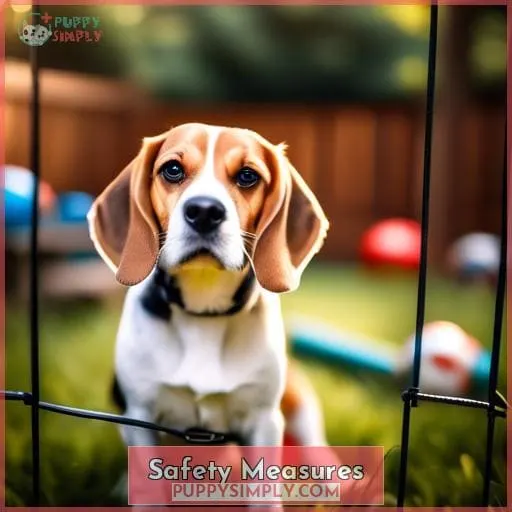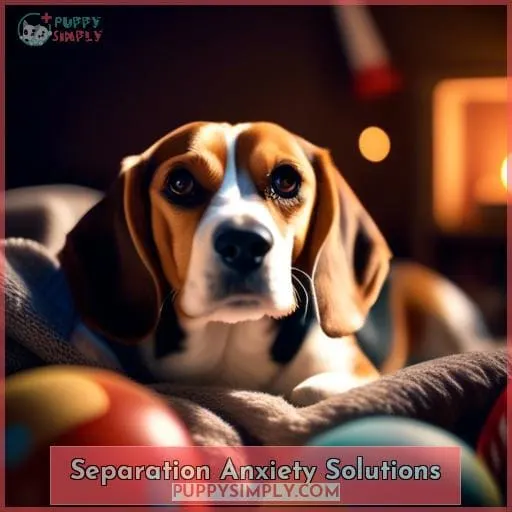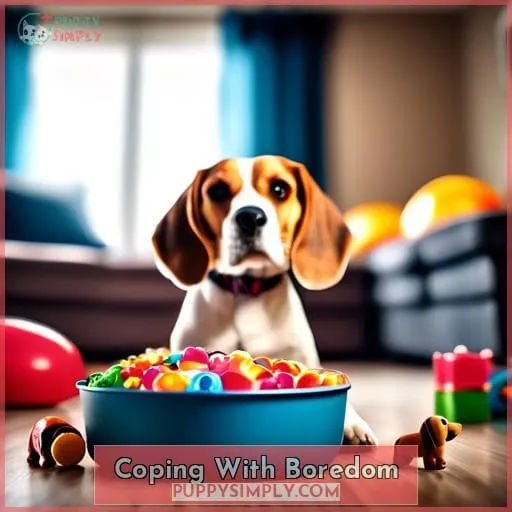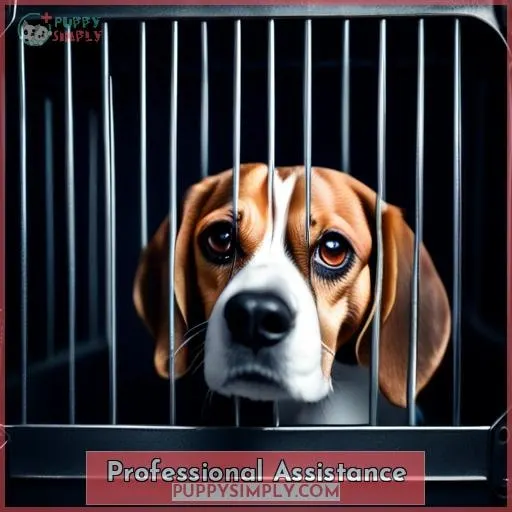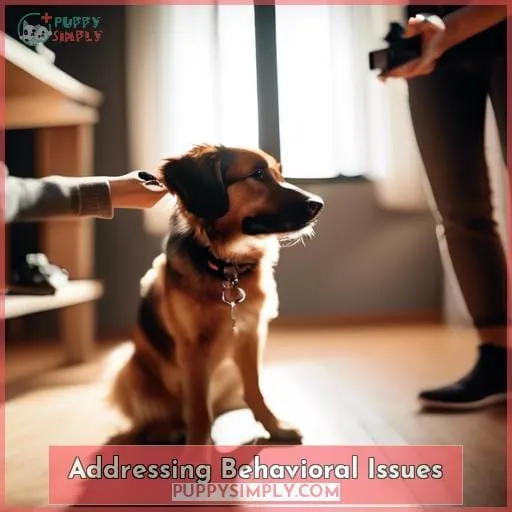This site is supported by our readers. We may earn a commission, at no cost to you, if you purchase through links.
 Beagles, those adorable, floppy-eared companions, have a reputation for being mischievous and energetic.
Beagles, those adorable, floppy-eared companions, have a reputation for being mischievous and energetic.
But what happens when you have to leave them alone?
Understanding how long your beagle can be left alone is crucial for their well-being and your peace of mind.
In this article, we’ll delve into the world of beagles, exploring their unique traits, separation anxiety triggers, and effective strategies to keep them safe and content when you’re away.
Let’s embark on this journey to ensure your beagle’s happiness and your stress-free time apart.
Table Of Contents
- Key Takeaways
- Understanding Beagles
- Alone Time Guidelines
- Safety Measures
- Separation Anxiety Solutions
- Training for Independence
- Coping With Boredom
- Physical Activity Needs
- Professional Assistance
- Addressing Behavioral Issues
- Community Insights
- Frequently Asked Questions (FAQs)
- What are some common signs of separation anxiety in Beagles?
- How can I create a safe and comfortable space for my Beagle when I’m away?
- What are some interactive toys or activities that can keep my Beagle entertained while alone?
- How can I gradually increase my Beagle’s alone time tolerance to prevent separation anxiety?
- Are there any breeds that are better suited for households with infrequent human presence compared to Beagles?
- Conclusion
Key Takeaways
- Beagle puppies can handle up to 3 hours alone, while adult Beagles can manage 4-6 hours with proper training.
- To prevent separation anxiety and boredom, provide interactive toys, mental stimulation, and consider getting a second dog for companionship.
- Use a crate or confine to a small, easy-to-clean room, and dog-proof the home to prevent access to dangerous objects or areas.
- Keep their minds and bodies active with interactive toys and games, establish a routine, and consider professional care options like doggy daycare or a pet sitter.
Understanding Beagles
Beagles are friendly, affectionate, and social dogs that thrive on human companionship.
Leaving them alone for extended periods can cause separation anxiety, resulting in destructive behavior, barking, and howling.
Understanding their behavior and needs is key to determining how long you can leave your Beagle alone.
Beagle Traits
Beagles are affectionate, energetic, and love being around people.
They’re also intelligent and curious, making them a joy to train.
With their friendly nature and love of exercise, Beagles make great companions for active families.
However, they do require regular exercise and grooming to stay happy and healthy.
If you’re considering getting a Beagle, be prepared to provide them with plenty of love, attention, and exercise.
Beagle History and Physical Attributes
Starting from the 16th century, Beagles were bred in England as rabbit-hunting hounds.
Today, they’re beloved family companions known for their short, sleek coats, typically in a tri-color pattern of tan, black, and white.
Beagles stand at about 15 inches tall, weigh between 20 and 25 pounds, and have a lifespan of 10 to 15 years.
With their strong sense of smell, Beagles excel as scent hounds, making them popular choices for hunting enthusiasts.
Alone Time Guidelines
As a Beagle owner, you’ll need to understand the breed’s specific alone time guidelines to ensure their well-being.
Beagle puppies can handle up to 3 hours alone, while adult Beagles can manage 4-6 hours with proper training.
However, exceeding these limits can lead to separation anxiety, boredom, and destructive behaviors.
To prepare your Beagle for alone time, start crate training early.
Introduce the crate as a safe and comfortable space, gradually increasing the time spent inside.
Positive reinforcement and establishing a routine can also help them adjust.
To keep them occupied during alone time, provide interactive toys, mental stimulation, and consider getting a second dog for companionship.
Safety Measures
To keep your Beagle safe while you’re away:
- Consider crate training or confining it to a small, easy-to-clean room.
- Dog-proof your home by:
- Blocking access to certain areas.
- Keeping trash cans out of reach.
- Avoiding leaving food on tables or counters.
Use a Crate
To ensure your Beagle’s safety and comfort while alone, let’s delve into the details of crate training.
Choose a crate that allows your Beagle to stand, sit, and turn around comfortably.
Make it a cozy den with a soft bed, chew toys, and a familiar blanket.
Avoid using the crate as punishment, as this can create anxiety and resistance.
Instead, turn it into a positive space with crate games and treats.
With patience and positive reinforcement, your Beagle will learn to love their crate, making it easier to leave them alone without worry.
Confining to a Small Room
Along with using a crate, you can confine your Beagle to a small, easy-to-clean room when leaving it alone.
Choose a room that’s free of hazards and has a comfortable bed, water bowl, and toys.
Visit your Beagle frequently to prevent boredom and separation anxiety.
Rotate toys and add enrichment items regularly to keep your Beagle stimulated.
Dog-Proofing the House
Dog-proof your home to prevent your Beagle from accessing dangerous objects or areas while you’re away.
Choose a room easy to clean and block access to other rooms with baby gates.
Use pet-proofing products to cover sharp corners, secure electrical cords, and keep trash cans out of reach.
Supervised freedom in a safe space gives your Beagle peace of mind.
Separation Anxiety Solutions
Don’t let your Beagle’s separation anxiety ruin your life or their home.
Create a safe space for them.
Keep their minds and bodies active.
Consider professional care options like doggy daycare or a pet sitter.
Creating a Safe Space
You can create a safe and comfortable space for your Beagle when you’re away to help reduce their anxiety.
Start by crate training them, gradually accustoming them to the crate as their cozy den.
Ensure the crate is the right size, offering enough space to move around comfortably.
Introduce soft bedding, toys, and treats to make it inviting.
This safe haven will help your Beagle feel secure and relaxed even when you’re not around.
Keeping Them Entertained
To keep your Beagle engaged and prevent boredom-driven anxiety, provide a variety of interactive toys and games.
Choose chew toys that challenge their intelligence and keep them occupied for hours.
Puzzle feeders and treat-dispensing toys are great for mental stimulation.
Rotate toys regularly to maintain their interest and prevent boredom.
Interactive games like fetch and hide-and-seek are excellent ways to bond with your Beagle and provide physical and mental exercise.
Professional Care Options
When faced with severe separation anxiety, consider enlisting the help of doggy daycare or hiring a dog walker.
These professional care options offer a safe and structured environment for your Beagle, ensuring their needs are met while you’re away.
Explore reputable dog sitter services or house sitter options for personalized attention and in-home comfort.
Research boarding facilities that prioritize safety and well-being, and consider pet insurance coverage for unexpected medical expenses.
Training for Independence
To teach your Beagle independence:
- Start crate training to create a safe space.
- Use positive reinforcement to reward good behavior.
- Establish a daily routine that includes regular exercise and attention to reduce anxiety and make being alone less stressful.
Crate Training
One way to train your Beagle for independence is through crate training, which involves gradually accustoming your dog to spending time in a crate while you’re away.
Choose an appropriate crate size that allows your Beagle to stand up, turn around, and lie down comfortably.
Make the crate a comfortable space with a soft bed, blanket, and a few of their favorite toys.
Avoid using the crate as punishment, as this can create a negative association with the crate and make your Beagle resistant to going in it.
Positive Reinforcement
By rewarding your Beagle with treats, toys, or praise whenever they behave well while alone, you can positively reinforce good behavior.
This technique, often called clicker training, establishes a reward system that motivates your Beagle to behave as desired.
Positive reinforcement shapes behavior by making favorable actions more likely to recur.
Start by rewarding small steps toward independence, gradually increasing the duration of alone time as your Beagle earns rewards.
This compassionate approach builds trust, strengthens your bond, and helps your Beagle feel secure even when alone.
Establishing a Routine
To train your Beagle to be comfortable with alone time, establish a consistent routine that includes regular feeding, exercise, and attention. This predictability will help them feel secure and less anxious when left alone.
Feed your Beagle at the same time each day.
Take your Beagle for a walk or play fetch at the same time each day.
Give your Beagle attention and affection at the same time each day.
Stick to this routine as much as possible, even on weekends and holidays.
Rewarding Good Behavior
Following a routine, reward your Beagle for good behavior when alone.
Rewarding patience and calmness instills confidence and independence.
The table below outlines specific rewards for desired behaviors:
| Behavior | Reward | Reason |
|---|---|---|
| Staying calm in crate | Treat or toy | Reinforces positive association with crate. |
| Entering crate voluntarily | Verbal praise | Encourages independence and calmness. |
| Remaining calm while you’re away | Treat or activity | Positive reinforcement for desired behavior. |
| Not barking excessively | Special treat or game | Rewarding calmness and reducing nuisance behavior. |
Rewarding good behavior reinforces desired traits, builds a stronger bond, and makes alone time less stressful for both you and your Beagle.
Coping With Boredom
When left alone, boredom can spark destructive behavior, so provide your Beagle with interactive toys that challenge their intellect and keep them stimulated.
Consider getting a second dog for companionship to help ease their boredom and anxiety when you’re not around.
Mental Stimulation
Keeping your Beagle occupied with mental stimulation is essential for preventing boredom and destructive behaviors while home alone.
Offer treat rewards during training exercises to reinforce good behavior and keep your Beagle engaged.
Interactive games, puzzle toys, and enrichment feeders challenge their minds and provide a sense of accomplishment.
Rotate toys regularly to maintain their interest and prevent boredom.
These strategies stimulate your Beagle’s intellect, reducing the likelihood of separation anxiety and destructive behaviors when left alone.
Interactive Toys
You can keep your Beagle occupied and alleviate boredom by providing interactive toys that stimulate their mind and encourage play.
These toys come in various forms:
- Chewable objects
- Puzzle feeders
- Treat-dispensing balls
Interactive toys engage your Beagle’s natural instincts, providing mental stimulation and entertainment, which helps reduce boredom and anxiety.
Second Dog for Companionship
Adding a canine companion eases the Beagle’s loneliness by providing friendship and attentiveness.
Select a breed that complements your Beagle’s specific quirks, ensuring compatibility and harmony.
Dog parks and socialization activities offer opportunities for interaction and exercise.
Explore Beagle breed clubs for breed-specific insights and potential playmates.
Consider doggy daycare options for additional companionship and structured playtime.
Physical Activity Needs
Beagles are energetic pups who need daily exercise to stay happy and healthy.
You can’t just leave them home alone all day without providing them opportunities to run, play, and sniff around.
Not meeting their physical needs can result in boredom, destructive behavior, and weight gain.
Exercise Requirements
To keep your Beagle happy and healthy, you’ll need to provide them with ample opportunities for physical exercise.
Beagles are energetic dogs that require daily walks, outdoor activities, and playtime to burn off their energy and stay fit.
Regular exercise not only keeps them physically healthy but also mentally stimulated and prevents boredom, which can lead to destructive behaviors.
Aim for at least 30 minutes of moderate exercise each day, and adjust the intensity and duration based on your Beagle’s age, health, and energy level.
Energy Levels
The physical activity needs of your Beagle, like daily brisk walks, help burn off energy and prevent destructive behavior from boredom.
They’re a highly energetic breed that can easily become restless and hyperactive if not given enough exercise.
To manage their energy levels, establish an exercise routine that includes walks, playtime, and obedience training.
This routine will help them stay fit and focused, preventing behavioral problems and promoting overall well-being.
Professional Assistance
If you need to leave your Beagle alone for longer than is ideal, you can consider:
- Hiring a dog walker to visit your Beagle during the day.
- Enrolling your Beagle in doggy daycare to give them a safe and fun place to stay while you’re away.
Doggy Daycare
If you’re regularly out of the house for extended periods, consider enrolling your Beagle in a doggy daycare to ensure its well-being.
Doggy daycare offers socialization, exercise, and mental stimulation, all crucial for a Beagle’s happiness and health.
Explore local doggy daycare options, ensuring they’re reputable and meet your Beagle’s needs.
The cost may vary, but the benefits are invaluable.
Doggy daycare can prevent separation anxiety, boredom, and destructive behaviors, giving you peace of mind while you’re away.
Hiring a Dog Walker
In addition to doggy daycare, hiring a dog walker can provide your Beagle with exercise, socialization, and attention while you’re away.
Ensure the dog walker is experienced, insured, and has excellent references.
Discuss the hiring process, fees, availability, and services in detail.
A dog walker can give your Beagle the companionship and exercise it needs while you’re gone, giving you peace of mind knowing your furry friend is well cared for.
Addressing Behavioral Issues
If your Beagle shows signs of anxiety, like pacing or howling, you can help them cope:
- Provide a comfortable space.
- Offer interactive toys.
- Play calming music when they’re alone.
It’s also important to work on training and socialization to help your Beagle feel more confident and secure.
Coping Strategies for Owners
With a Beagle prone to separation anxiety, you can adopt coping strategies to address any behavioral issues that may arise when they’re alone.
Start by ensuring they get enough exercise and mental stimulation. Engage them with interactive toys and consider getting a second dog for companionship.
A structured routine, positive reinforcement, and crate training can also help manage their anxiety.
| Coping Strategy | Goal | How It Helps |
|---|---|---|
| Exercise and Playtime | Tire your Beagle physically and mentally | Reduces pent-up energy and boredom |
| Interactive Toys | Keep your Beagle engaged and stimulated | Prevents boredom and destructive behavior |
| Second Dog for Companionship | Provide social interaction and reduce loneliness | Alleviates separation anxiety |
| Structured Routine | Create a predictable schedule for your Beagle | Provides a sense of security and comfort |
Common Concerns and Solutions
Tackle your Beagle’s behavioral issues head-on:
- Pinpoint the root cause and implement effective solutions.
- Long walks and mental stimulation can curb destructive behavior.
Address howling control:
- Provide adequate exercise and attention.
- Crate training can ease separation anxiety.
Fulfilling exercise requirements is key to a well-behaved Beagle.
With patience and consistency, you can overcome behavioral hurdles and strengthen your bond with your furry friend.
Community Insights
Turn to beagle-loving communities like online forums or social media groups to gather insights and experiences from fellow owners. Learn from their successes and challenges in managing alone time with their beagles.
Separation anxiety triggers:
Hear firsthand accounts of common triggers that cause separation anxiety in beagles, such as changes in routine, lack of exercise, and insufficient mental stimulation.
Crate training challenges:
Get tips on how to overcome crate training obstacles, including crate aversion and potty training struggles. Discover creative solutions and techniques to make crate training a positive experience for your beagle.
Boredom prevention strategies:
Find out how other beagle owners keep their furry friends entertained and mentally stimulated while alone. Learn about interactive toys, puzzle feeders, and other creative ways to prevent boredom and destructive behavior.
Long walks necessity:
- Understand the importance of providing your beagle with adequate exercise to prevent pent-up energy and anxiety. Discover how regular walks can contribute to a beagle’s overall well-being and happiness.
Frequently Asked Questions (FAQs)
What are some common signs of separation anxiety in Beagles?
Separation anxiety in Beagles often shows through:
- Frantic barking
- Destructive chewing
- Excessive panting
- Pacing
- Accidents inside your home
Recognizing these signs can help you address your Beagle’s distress and create a more harmonious home.
How can I create a safe and comfortable space for my Beagle when I’m away?
Craft a cozy sanctuary for your Beagle,
A serene oasis away from the bustle of daily life.
Ensure their comfort with a soft bed,
Music, and toys,
Fostering a sense of security and tranquility in your absence.
What are some interactive toys or activities that can keep my Beagle entertained while alone?
Engage your Beagle’s senses with interactive toys:
- Puzzle feeders
- Treat-dispensing balls
- Scent games
Rotate toys regularly to maintain interest and prevent boredom.
How can I gradually increase my Beagle’s alone time tolerance to prevent separation anxiety?
To gradually increase your Beagle’s alone time tolerance:
- Start with short absences and gradually extend them as they get comfortable.
- Provide engaging toys and activities.
- Establish a routine.
- Create a safe and comforting space for them while you’re away.
Are there any breeds that are better suited for households with infrequent human presence compared to Beagles?
If you’re often away, consider a breed more independent than Beagles.
For example, Shiba Inus are less prone to separation anxiety and can handle solitude better.
Conclusion
Like a lone wolf howling at the moon, your beagle’s plaintive cries echo through the empty house, a symphony of loneliness.
Prevent this sorrowful serenade by understanding your beagle’s needs, providing ample stimulation, and training for independence.
With patience and dedication, you’ll ensure your beagle’s happiness, even when you’re not around, fostering a bond that time can’t break.



